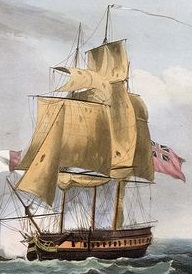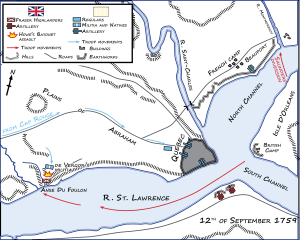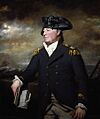HMS Lizard (1757) facts for kids

Lizard was built to the same design as HMS Carysfort (pictured)
|
|
Quick facts for kids History |
|
|---|---|
| Name | HMS Lizard |
| Ordered | 13 April 1756 |
| Builder | Henry Bird, Globe Stairs, Rotherhithe |
| Laid down | 5 May 1756 |
| Launched | 7 April 1757 |
| Completed | 1 June 1757 at Deptford Dockyard |
| Commissioned | March 1757 |
| Honours and awards |
|
| Fate |
|
| General characteristics | |
| Class and type | 28-gun Coventry-class sixth-rate frigate |
| Tons burthen | 59487⁄94 (bm) |
| Length |
|
| Beam | 33 ft 11 in (10.3 m) |
| Depth of hold | 10 ft 6 in (3.20 m) |
| Sail plan | Full-rigged ship |
| Complement | 200 |
| Armament |
|
HMS Lizard was a 28-gun frigate, a type of warship, used by the Royal Navy from 1757 to 1828. It was named after the Lizard, a famous peninsula in Cornwall, England. This ship was known for being wide and strong, built to stay at sea for a long time.
Lizard had a crew of 200 sailors and was armed with 24 large cannons, plus smaller guns. Even though it was built tough, the ship often needed repairs.
It was active in several big wars between 1757 and 1793. These included the Seven Years' War, the American Revolutionary War, and the French Revolutionary War. Lizard helped in important naval battles in the Caribbean and North America. It played a part in the British capture of Quebec City and Montreal, the Siege of Havana, and the Battle of St Kitts. The ship also won nine battles against enemy ships, mostly French privateers, in waters near America and Europe.
After 1794, Lizard was no longer used for fighting. It became a hospital ship in 1800, helping sick sailors near Burntwick Island. It stayed in this role for 28 years, becoming the last ship of its kind still in use. In 1828, 71 years after it was launched, Lizard was sold for scrap.
Contents
Building the Lizard
How the Ship Was Designed
The Lizard was a 28-gun frigate, a type of fast warship. It was one of 18 ships in the Coventry-class. These ships were designed similarly to another successful frigate, HMS Tartar. The Royal Navy decided to build these ships when the Seven Years' War began. Since the main Royal Navy shipyards were busy building bigger warships, most Coventry-class ships, including Lizard, were built by private companies. This helped get them ready faster.
The contract to build Lizard was given to Henry Bird in Rotherhithe on April 13, 1756. The plan was to finish the 28-gun ship within 12 months. Private shipyards had some freedom to make small changes to the design.
The ship's main frame, called the keel, was laid down on May 5, 1756. The building went quickly, and the ship was ready to launch by April 1757, ahead of schedule. When finished, Lizard was about 36 meters (118 feet) long. Henry Bird received payment for his work.
The ship was named after the Lizard, a well-known point of land in Cornwall. This was part of a tradition of naming ships after places. Most other ships in its class were also named after places or figures from ancient history.
Crew and Weapons
The Lizard was designed for a crew of 200 people. This included a captain and a lieutenant, along with other officers, sailors, and Royal Marines.
For weapons, Lizard had 24 large 9-pounder cannons on its main gun deck. It also had four smaller 3-pounder cannons on the quarterdeck and 12 half-pounder swivel guns along its sides.
How Well It Sailed
The Lizard was similar to French frigates of its time, but it had a shorter, stronger body and more powerful side-firing guns. It was also wide, which meant it had plenty of space for supplies and a large storage area for gunpowder. These features helped Lizard turn more easily and stay at sea for longer without needing to resupply.
The ship had strong, heavy masts. These helped balance the ship's weight, made it stable in rough seas, and allowed it to carry more sails. However, this heavy design also meant the ship was less agile and slower in light winds.
Throughout its time at sea, Lizard had many construction and repair problems. It needed seven major repairs between 1769 and 1793. Private shipyards often used thinner wood for the hull than the Royal Navy's own shipyards. This made the ships less strong. Also, during the Seven Years' War, good, aged wood was scarce. So, smaller ships like Lizard were often repaired with new wood that could warp as it dried, causing cracks and leaks.
Lizard in the Seven Years' War
Early Battles in the Atlantic (1757–1758)
Captain Vincent Pearce took command of Lizard in March 1757, even before it was fully built. The ship was launched on April 7 and then sailed to Deptford Dockyard to be fitted out and get its crew and weapons. By June 1, it was ready and immediately went to sea.
Britain was at war with France, and Royal Navy ships often escorted merchant fleets and hunted French privateers (privately owned ships that attacked enemy shipping). Lizard got its first victories on July 12, 1757. It captured a 6-gun French privateer called L'Hiver and rescued a British merchant ship that the French had captured. Both captured ships were sent to Kinsale, Ireland, as prizes.
In 1758, Lizard joined a group of ships blocking the French port of Brest. On September 12, Lizard and another British ship, HMS Unicorn, spotted a group of French coastal ships with two escorting frigates. The French tried to hug the shoreline to avoid the British. Lizard successfully got between the French merchant ships and their escorts. One French frigate, Calypso, ran aground and was destroyed. Many French merchant ships were then captured or sunk by the British. On October 2, Lizard also chased and defeated Duc d'Hanovre, a 14-gun French privateer.
Fighting in the Americas (1759–1763)

In October 1758, Captain Doake took command, and Lizard was sent to North America. It joined a large British fleet planning to invade Québec in 1759. After winter, Lizard sailed from England in February 1759 and joined the fleet in Nova Scotia. By June 26, the fleet, led by Vice-Admiral Charles Saunders, was anchored near Quebec City.
There wasn't much for frigates like Lizard to do directly at Quebec City. However, on September 12, Lizard's marines were part of a landing below the town. This was a trick to distract the French from the main British landing upstream by General James Wolfe at the Battle of the Plains of Abraham. Wolfe's attack was successful, and Quebec City surrendered on September 17. Lizard then returned to England.
The British continued their campaign in Québec in 1760, planning to attack Montreal. After spending the winter in England, Lizard returned to North America in February to help the British fleet on the St. Lawrence River. After Montreal fell in September, Lizard was sent to the Leeward Islands in the Caribbean. Its job there was to hunt privateers and protect merchant ships.
Britain then planned to invade Martinique, a French stronghold in the Caribbean. Lizard had its guns increased to 32 and joined a large fleet under Admiral George Rodney in January 1762. The ship was present when the British landed, and although it didn't directly fight, its crew received a share of the captured goods from the French settlement.
Lizard then prepared for a British attack on Havana, the capital of Spanish Cuba. In May 1762, a fleet of about 200 British ships gathered for the siege. Lizard joined in June and became the flagship for Commodore James Douglas. Captain Francis Banks took command of Lizard around this time. Havana fell to the British in late July.
The war with France and Spain ended with the Treaty of Paris in March 1763. Lizard was no longer needed for war, so it returned to England in June and was taken out of service.
Peacetime Service
For the next six years, Lizard stayed anchored. A survey in 1769 found it was not seaworthy and needed a lot of repairs. These repairs took 16 months and cost more than the ship's original building price.
In 1770, a dispute arose with Spain over the Falkland Islands. The Royal Navy prepared ships for a relief mission. Lizard was recommissioned in October 1770 under Captain Charles Inglis. However, its repairs continued, and it wasn't ready until December 1770. By January 1771, Britain and Spain signed a treaty, ending the dispute, so Lizard was no longer needed for that mission.
In June 1771, Lizard sailed to Gibraltar without any problems. It then stayed at Portsmouth until September, when it was sent to patrol and hunt privateers along the North American coast. After three years there, it returned to England and was taken out of service again.
American Revolutionary War
Lizard was prepared for active service again in June 1775, after the American Revolutionary War began. Under Captain John Hamilton, it was sent back to the St. Lawrence River, the same area it had served in the previous war. Captain Thomas Mackenzie took command in June 1776. Six months later, on December 4, it captured the American privateer Putnam.
The ship sailed to England in early 1777 for repairs. It then returned to North American waters. More repairs were done in 1779 and 1780, including covering its hull with copper to protect the wood from shipworms. Captain Francis Parry replaced Mackenzie, and Lizard was then assigned to the English Channel. On May 18, 1780, it captured an enemy cutter called Jackal.
In 1781, Captain Parry was promoted, and Captain Edmund Dod took command of Lizard. The frigate was assigned to protect a group of merchant ships sailing to the West Indies. It arrived in April and joined the Navy's Leeward Islands fleet, patrolling near Martinique and Jamaica. In January 1782, it joined a fleet under Admiral Sir Samuel Hood, heading to help the British settlement on Saint Kitts. On the way, Lizard found and captured a 16-gun French cutter called l'Espion, which was carrying artillery shells and ammunition. The French ship was taken as a prize.
After helping at St. Kitts, Lizard returned to the Leeward Islands. However, peace talks with France began in 1782, meaning less naval activity was needed. In September 1782, Lizard returned to Britain, was taken out of service, and its crew moved to other ships.
French Revolutionary Wars
Lizard stayed anchored on the River Thames for six years, undergoing slow repairs to keep it seaworthy. In early 1790, unrest in France led the Admiralty to increase the number of active ships. Lizard was chosen to return to sea. It was refitted from May to August 1790 and recommissioned under Captain John Hutt in September.
For eight months, the frigate served as a "receiving ship" for sailors forced into naval service by press gangs. In June 1791, it joined a squadron sailing to Jamaica. The trip was smooth, and Lizard returned to Britain in September 1791. After more refitting, it returned to sea in December 1792 for the War of the First Coalition against France. Under Captain Thomas Williams, the frigate hunted privateers in the North Sea. In March 1793, it had three quick victories, capturing the French privateers Les Trois Amis, Las Vaillant Custine, and the 8-gun Le Sans-Cullotte. All were sent back to British ports as prizes.
Despite these successes, the 40-year-old ship was nearing the end of its active career. After one more year in the North Sea, it returned to Portsmouth in May 1794 and was permanently removed from military duties.
Becoming a Hospital Ship
The old Lizard remained unused at Portsmouth for five years. In 1799, it was brought to Chatham Dockyard to be changed into a hospital ship. This happened during a time when people worried that diseases like yellow fever and bubonic plague could come to Britain on ships from the Mediterranean.
After its conversion in 1800, Lizard sailed to Stangate Creek, near Burntwick Island in Kent. Its job was to care for sick sailors from merchant ships that were being quarantined. It was joined by two other old Navy ships, Valiant and Duke, which were also made into floating hospitals.
This hospital ship assignment was meant to be temporary. A permanent quarantine station was planned, but work on it stopped in 1810 due to high costs and the swampy, disease-prone land. Valiant returned to sea in 1803, but Lizard and Duke stayed at Stangate Creek for the next 28 years. They took care of patients from ships quarantined at other ports.
The worn-out Lizard was finally removed from Navy service in 1828. It was towed to Sheerness Dockyard to be decommissioned. On September 22, 1828, it was sold, likely for scrap, for £810.
Images for kids
-
On 12 September 1759, Lizard's marines took part in a downstream assault on Quebec City ("Saunders' diversion," top right of map), while the main British force landed upstream at Anse-au-Foulon.






